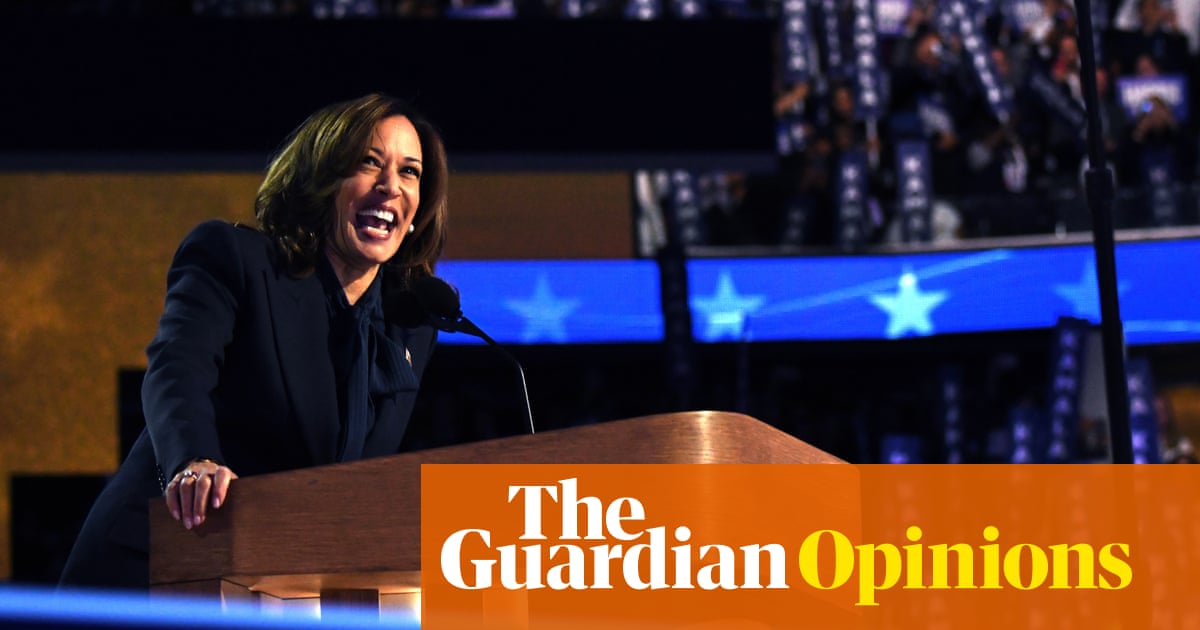If you’re not across much of popular culture, the US election may require some interpretation. The Democratic National Convention has been an exercise in creating a theatrical cast drawn from celebrity, music and drama. Take, for instance, Nancy Pelosi, the “Mother of Dragons” – a main character in Game of Thrones – as she was introduced at the DNC. A dragon tamer who was also introduced as “brat before brat was brat” (a buzzy reference to the musician Charli xcx’s album of the same name, which denotes a confident, nonchalantly rebellious woman). Kamala Harris herself was anointed as “brat” the moment that Joe Biden stepped down, but already Harris’s mother – who had Indian heritage and raised Harris as a single parent – has been declared the uberbrat, more brat than even her daughter.
If all that’s too obscure, perhaps Taylor Swift is a more familiar touchstone. Commentators have suggested that Swift’s boyfriend, the NFL player Travis Kelce, has much in common with vice-presidential candidate and Harris running mate Tim Walz, and more broadly with the “wife guys” of the DNC – all of whom are men who, while confident in their masculinity, are not ashamed to talk up their wives and girlfriends and take a back seat. Harris has captured this loose amalgamation of cinematic performance and cultural zeitgeist by delivering liberals what they sorely need: a “Beyoncé moment”. She is experiencing her “Renaissance”, according to the New York Times columnist Charles M Blow – a reference to the spectacular pyrotechnic tour that elevated Beyoncé to pop icon status. The rumour that Beyoncé herself was appearing as a surprise guest at the DNC drew much speculation, as if her presence alone would bless the campaign and ordain its political legitimacy.
Meme, celebrity and cultural symbolism have become the language not only of political performance but also of political analysis and media coverage. The worlds of social media and politics have fully converged, producing a sort of extended entertainment event. Harris’s transformation itself, within days, from a relatively low-impact and low-presence vice-president to the juggernaut she has become has involved a hectic re-scripting. Only a year after she assumed vice-presidential office, the question was “where did it go wrong” for Harris. She was “hobbled in the public consciousness”. Early last year, the New York Times reported that “even some Democrats whom her own advisers referred reporters to for supportive quotes confided privately that they had lost hope in her”.
Her rapid rehabilitation into the Beyoncé of politics stems in part from panic. For a moment, it looked as though Biden really was going to dig his heels in and refuse to step aside – which would have delivered a definite win to Donald Trump. Then the assassination attempt on Trump gave him his own narrative boost, which through meme, music and online reaction similarly coalesced to frame Trump as a potent winner against a frail incumbent. Harris emerged when it seemed as though all might be lost. The plot didn’t twist so much as it was forcefully twisted, offering up Harris as a fusion of feelgood cultural references and memeable content.
This all feels symptomatic both of liberals’ political anxieties and their pandering to changing habits of political consumption. With every election, new generations come online and older generations receive more of their news as internet content which cycles through the political sphere. For opinion-makers for whom Barack Obama’s presidency turned into the nightmare of Trump, this fevered rehabilitation of Harris feels like an urgent duty. The chance of another Obama era is within touching distance so long as they make Harris happen. With that comes a tendency to focus on their precious outcome with a zeal that leaves little space for scrutinising their candidate (Labour sceptics before the last general election may relate), and the infantilisation of a public that cannot be trusted in a cutthroat media market where political lives are increasingly determined by clips and fragments. “The survivalist in me,” says Blow, as opposed to the journalist, believes that Harris should continue not to give interviews in case one bad answer overshadows 10 good ones.
These tendencies have also been accelerated by the real prospect of a second Trump term and the omnipresent shadow he has cast since 2016. Since his first election, a rightwing movement whose power lies in nastiness and loathing has grown under Trump’s dominion. Democrats may be hoping the alternative to this darkness lies in presenting Harris as the “president of joy”, as Bill Clinton recently called her.
But feed people feelings alone and they will also respond in the same way, captive only as long as the energy can be maintained, and as long as the other side doesn’t catch a good wind that sends the story in another direction. Feelings are fickle and images are fragile. Rather than building a durable movement, the result is vibe fare aimed at dopamine-addicted consumers who could be swayed either way.
The adherence to sensation rather than substance may seem sensible if you’re assuming that the electorate cannot be relied on to make decisions based on detail and scrutiny – and if you believe the safest denominator that binds voters in a divided nation is to present them with a politics that neither draws on their material realities nor articulates a clear vision of a better future, but rather taps into their status as consumers of rousing spectacle. It seems like a high-risk strategy in a high-stakes election, one in which the Democrats may come to find out that the voter is unpredictable, capricious, and unswayed by party lines or political convention. Or in a word, “brat”.
